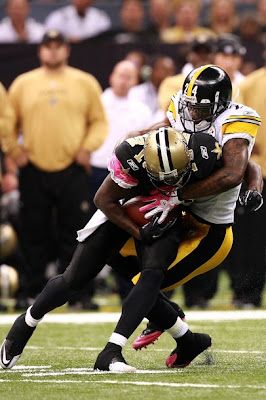By Gene Collier, Pittsburgh Post-Gazette
http://www.post-gazette.com/sports/
As the Steelers implemented some of their final adjustments for Monday night's appointment in Cincinnati, there was little tangible proof that anything that can go wrong won't go wrong.
The crowd noise they blared against the starting offense Friday afternoon didn't really approach the decibel level that bedeviled them in Louisiana, and no one swore any oaths that this week's recommendations from upstairs on whether or not to challenge an official's call won't be based on tonight's episode of "Desperate Housewives."
Presumably, Mike Tomlin's assistants will tune in nothing but the game feed for all 60 minutes, but stranger things have happened.
 NEW ORLEANS - OCTOBER 31: Ike Taylor tackles Marques Colston of the New Orleans Saints at Louisiana Superdome on October 31, 2010 in New Orleans, Louisiana. The Saints won 20-10 over the Steelers. (Getty Images)
NEW ORLEANS - OCTOBER 31: Ike Taylor tackles Marques Colston of the New Orleans Saints at Louisiana Superdome on October 31, 2010 in New Orleans, Louisiana. The Saints won 20-10 over the Steelers. (Getty Images)Moreover, this week's leading Steelernomic indicators were mixed, none so mixed as the implications of this one figure: 68 percent.
That's the portion of forward passes that are completed against Dick LeBeau's defense, and while it looks dangerously bloated on its face, it's actually worse than that: It's the highest such figure around here in at least 42 years. It's the highest since at least 1968, which takes you back to the statistical dark ages, long before software, when the numbers being written down in NFL press boxes were subject to the bell curve vagaries from Sister Mary Abacus' 12th-grade math class and many other variables.
But the hard arithmetic truth is, only four times since 1969 have opponents completed even 60 percent of their passes against the Pittsburgh Steelers, and almost halfway through this season, the figure is a lot closer to 70 percent.
Not that it necessarily matters, I hear.
"No, not at all," said Troy Polamalu when I asked him if that inflated figure concerns him. "They can make it 75 percent and it wouldn't bother me, because mostly they're throwing screens, quick hitches and curls. It's not like they're picking up big yardage every time they throw."
No one has looked harder at these kinds of things over a longer period of time perhaps than LeBeau himself, partly because of his passion for defensive football, for pass defense in particular, and partly because his father was an accountant whom he so much admired.
LeBeau loves numbers, even to the extent that he's developed a kind of master formula for winning defense based on the numbers 3.7, 4.7, and 5.7.
"The first one is yards per rush, the second is yards per play, and the third is yards per throw," LeBeau explained. "Not yards per reception. Yards per throw."
If your defense is capping opponent production at or below those numbers, you're probably winning, but this is no graduate level accounting course. That's why the old professor is quick to add this caveat.
"Of course," LeBeau said, "the main thing is points."
Of course, points.
The Steelers have allowed fewer than any team in the league, 102, but points are to some extent a variable impacted by things the defense cannot control, such as the percentage of time your offensive teammates keep the opposing offense on the sideline. In at least one sense then, the numbers in LeBeau's master formula are a truer indicator of defensive performance per se.
"I would say the important stats for a defense are red zone efficiency, third-down efficiency, things like that," said Polamalu. "For the offense, it's all about sustaining drives. If you're completing screens and curls on third-and-15, that doesn't hurt the defense at all. There are very few offenses, like New England's with Tom Brady, who are patient enough to go all the way downfield using nothing but those kinds of passes because they're so good at it."
All points well taken, but LeBeau would tell you that his formula has taken all those things into account. So if you love to fret -- and judging by my e-mail, you love few things more -- you can start with the 2010 defense's performance against its own goals.
The run defense might be headed for a landmark season, allowing 2.6 yards per attempt as attempts themselves continue to dwindle, as they just make little sense. So this defense is more than a full yard per attempt better than the 3.7 goal.
Yards per play is another matter. It's at 4.98 through seven games, significantly above the 4.7 standard of excellence.
Yards per pass attempt is 6.4, way over the 5.7 standard, but LeBeau cites 5.9 as the more accurate figure, adding in 20 attempts that turned out to be sacks.
"We'd like to get the pass number lower," said the defensive coordinator, sounding anything but displeased.
That's because any way you wring it out, this defense is still among the NFL's top 10 in 13 different defensive categories, but you might like to see them tighten some things down beginning tomorrow night.
Carson Palmer and the Bengals might well give them the opportunity. Palmer's fully culpable in the current three-game Bengals losing streak, and he completed only 44 percent of his passes last week against Miami. If he spikes that toward the 77 percent Pittsburgh allowed against Drew Brees, this Pittsburgh defense will be in for some far more serious analysis.
Gene Collier: gcollier@post-gazette.com.
Read more: http://www.post-gazette.com/pg/10311/1101370-150.stm#ixzz14cWLI5Wh


No comments:
Post a Comment